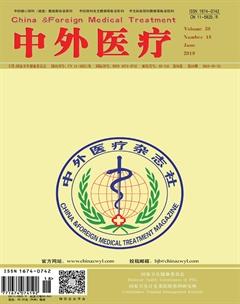小剂量多巴胺联合多巴酚丁胺与氨溴索联合人免疫球蛋白治疗小儿重症肺炎的疗效
刘莹

[摘要] 目的 探討在小儿重症肺炎患儿中氨溴索+人免疫球蛋白与小剂量多巴胺+多巴酚丁胺治疗的效果。 方法 此次方便抽选2017年2月—2019年2月期间该院医治的64例小儿重症肺炎患儿做研究,随机分为对照组(32例)、研究组(32例)。患儿均常规治疗,对照组患儿加小剂量多巴胺+多巴酚丁胺治疗,而研究组患儿加氨溴索+人免疫球蛋白治疗,对比两组的治疗费用、治疗时间、体征改善时间、治疗效果。 结果 研究组的治疗费用(1 520.12±135.84)元高于对照组(1 161.21±110.25)元,差异有统计学意义(t=11.604,P=0.000)。研究组的治疗时间(6.61±1.12)d、肺部啰音消失时间(3.20±0.76)d、三凹征消失时间(2.61±0.91)d、心率改善时间(3.40±0.15)d、呼吸改善时间(2.20±0.17)d均短于对照组患儿[(8.13±1.84)d、(4.41±0.73)d、(3.54±1.02)d、(4.50±0.18)d、(3.25±0.14)d],差异有统计学意义(t=3.992、6.495、3.849、26.557、26.971,P=0.000)。研究组的治疗总有效率(93.75%)高于对照组(90.63%),但差异无统计学意义(χ2=0.217,P=0.641)。 结论 在小儿重症肺炎患儿中,氨溴索+人免疫球蛋白与小剂量多巴胺+多巴酚丁胺治疗的总有效率相近,其中,氨溴索+人免疫球蛋白的治疗费用高,但是该方法的治疗时间短、患儿体征改善时间短。
[关键词] 小儿重症肺炎;氨溴索;人免疫球蛋白;多巴胺;多巴酚丁胺;疗效
[中图分类号] R5 [文献标识码] A [文章编号] 1674-0742(2019)06(c)-0115-03
[Abstract] Objective To investigate the effect of ambroxol + human immunoglobulin and low-dose dopamine + dobutamine in children with severe pneumonia. Methods Conveniently selected sixty-four children with severe pneumonia in our hospital who were treated in our hospital from February 2017 to February 2019 were randomly divided into the control group (32 cases) and the study group (32 cases). All children were treated routinely. The control group received low-dose dopamine + dobutamine treatment, while the study group received ambroxol + human immunoglobulin treatment. The treatment cost, treatment time and physical signs recovery time, treatment effect of the two groups were improved. Results The treatment cost of the study group (1 520.12±135.84)yuan was higher than that of the control group (1 161.21±110.25) yuan, and the difference was significant(t=11.604, P=0.000). The treatment time of the study group (6.61±1.12) d, the disappearance time of the lungs (3.20±0.76) d, the disappearance time of the three concave signs (2.61±0.91) d, the heart rate improvement time (3.40±0.15) d, the respiratory improvement time (2.20±0.17) d were shorter than those in the control group [(8.13±1.84) d, (4.41±0.73) d, (3.54±1.02) d, (4.50±0.18) d, (3.25±0.14) d], the difference was statistically significant (t=3.992, 6.495, 3.849, 26.557, 26.971, P=0.000). The total effective rate of treatment in the study group (93.75%) was higher than that in the control group (90.63%), but the difference was not statistically significant (χ2=0.217, P=0.641). Conclusion In children with severe pneumonia, the total effective rate of ambroxol + human immunoglobulin and low-dose dopamine + dobutamine is similar. Among them, ambroxol + human immunoglobulin is expensive. However, the method has a short treatment time and a short improvement in the physical signs of the child.

